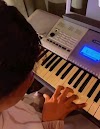#learn sheet music part8 Understanding and Playing Semiquavers (16th Notes)
#### Understanding Semiquavers
- **Semiquaver (16th Note):** This note represents 1/16 of a whole note.
- **Appearance:** A semiquaver has a filled-in note head, a stem, and two flags. When multiple semiquavers are together, they are connected by double beams.
- **Rhythmic Value:** In a 4/4 time signature, one semiquaver is 1/16 of the measure, or 1/4 of a beat. Four semiquavers fit into one quarter note beat.
#### Counting Semiquavers
- To count semiquavers within a beat, use the counting method: "1 e & a"
- For example, if you have four semiquavers in one beat:
- 1st semiquaver: "1"
- 2nd semiquaver: "e"
- 3rd semiquaver: "&"
- 4th semiquaver: "a"
#### Practical Exercises
1. **Clapping Exercise:**
- Practice clapping semiquavers to get a feel for their rhythm.
- Set a metronome to a slow tempo (e.g., 60 BPM).
- Clap while counting "1 e & a, 2 e & a, 3 e & a, 4 e & a" for each measure.
2. **Playing Semiquavers on One Note:**
- Choose a note (e.g., middle C).
- Play the note in semiquaver rhythm along with a metronome.
- Start slow (60 BPM) and gradually increase the speed as you become more comfortable.
- Example: Play four semiquavers per beat while counting "1 e & a".
3. **Simple Melody with Semiquavers:**
- Write or use a simple melody incorporating semiquavers.
- Example melody: C, D, E, F (all semiquavers), G (quarter note), E, F, G, A (all semiquavers), B (quarter note).
- Play this melody, ensuring accurate timing for each semiquaver.
### Summary
By practicing these exercises, you'll become comfortable with reading, counting, and playing semiquavers. Don't forget to share. Also check out part 1 to 7 via Vicpiano page










0 Comments